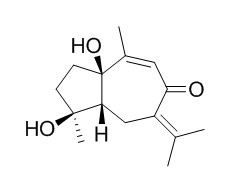Aerugidiol
Aerugidiol inhibits protein tyrosine phosphatase 1B (PTP1B).
Inquire / Order:
manager@chemfaces.com
Technical Inquiries:
service@chemfaces.com
Tel:
+86-27-84237783
Fax:
+86-27-84254680
Address:
1 Building, No. 83, CheCheng Rd., Wuhan Economic and Technological Development Zone, Wuhan, Hubei 430056, PRC
Providing storage is as stated on the product vial and the vial is kept tightly sealed, the product can be stored for up to
24 months(2-8C).
Wherever possible, you should prepare and use solutions on the same day. However, if you need to make up stock solutions in advance, we recommend that you store the solution as aliquots in tightly sealed vials at -20C. Generally, these will be useable for up to two weeks. Before use, and prior to opening the vial we recommend that you allow your product to equilibrate to room temperature for at least 1 hour.
Need more advice on solubility, usage and handling? Please email to: service@chemfaces.com
The packaging of the product may have turned upside down during transportation, resulting in the natural compounds adhering to the neck or cap of the vial. take the vial out of its packaging and gently shake to let the compounds fall to the bottom of the vial. for liquid products, centrifuge at 200-500 RPM to gather the liquid at the bottom of the vial. try to avoid loss or contamination during handling.
Biomed Pharmacother.2024, 181:117658.
Korean J Environ Agric.2018, 37(4):260-267
Mol Pharm.2018, 15(8):3285-3296
Int J Mol Sci.2023, 24(8):7045.
J Korean Soc Food Sci Nutr2023, 52(11):1101-1110
Molecules.2021, 26(6):1738.
Environ Toxicol.2024, 39(5):2927-2936.
Am J Chin Med.2022, 1-20.
Front Plant Sci.2022, 13:982771.
J.Food Processing & Preservation2022, jfpp.16666
Related and Featured Products
J Nat Prod. 2013 Feb 22;76(2):223-9.
Sesquiterpenes from the rhizomes of Curcuma heyneana.[Pubmed:
23387824]
METHODS AND RESULTS:
Four new germacranes [heyneanones A-D (1-4)], three new guaianes [4,10-epizedoarondiol (5), 15-hydroxyprocurcumenol (6), 12-hydroxycurcumenol (7)], and two new spirolactones [curcumanolides C (8) and D (9)] were isolated from the rhizomes of Curcuma heyneana together with 13 known sesquiterpenes and two known labdane-type diterpenes.
CONCLUSIONS:
Among the isolated compounds, heyneanone A (1), heyneanone C (3), 4,10-epizedoarondiol (5), procurcumenol (16), Aerugidiol (17), zerumin A (23), and (E)-15,16-bisnorlabda-8(17),11-dien-13-one (24) inhibited protein tyrosine phosphatase 1B (PTP1B) with IC(50) values of 42.5, 35.2, 35.1, 45.6, 35.7, 10.4, and 14.7 μM, respectively.
Molecules. 2013 Feb 6;18(2):2110-21.
Simultaneous determination of multiple sesquiterpenes in Curcuma wenyujin herbal medicines and related products with one single reference standard.[Pubmed:
23389255]
Some Curcuma species are widely used as herbal medicines. Sesquiterpenes are their important bioactive compounds and their quantitative analysis is generally accomplished by gas chromatography (GC) or high performance liquid chromatography (HPLC), but the instability and high cost of some sesquiterpene reference standards have limited their application.
It is necessary to find a practicable means to control the quality of herbal medicines.
METHODS AND RESULTS:
Using one stable component contained in Curcuma species to determine multiple analogues should be a practical option. In this study, a simple HPLC method for determination of sesquiterpenes using relative response factors (RRFs) has been developed. The easily available and stable active component curdione was selected as the reference compound for calculating the RRFs of the other eight sesquiterpenes, including zedoarondiol (Zedo), isozedoarondiol (Isoz), Aerugidiol (Aeru), (4S,5S)-(+)-germacrone-4,5-epoxide (Epox), curcumenone (Curc), neocurdione (Neoc), germacrone (Germ) and furanodiene (Fura). Their RRFs against curdione were between 0.131-1.301, with a good reproducibility. By using the RRFs, the quantification of sesquiterpenes in Curcuma wenyujin herbal medicines and related products was carried out.
CONCLUSIONS:
The method is especially useful for the determination of (4S,5S)-(+)-germacrone-4,5-epoxide, curcumenone, germacrone and furanodiene, which often are regarded as the principle components in Curcuma species, but unstable when were purified. It is an ideal means to analyze the components for which reference standards are not readily available.



